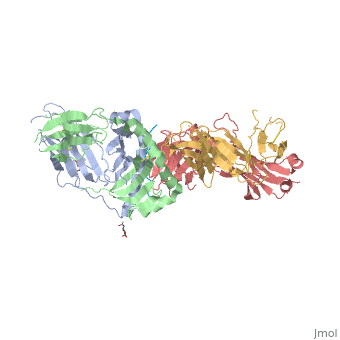Gunnar Reiske/Sandbox 102
From Proteopedia
m |
|||
| Line 17: | Line 17: | ||
It is unclear why only specific indiviudals produce this pathogenic and T-cell specific activation. Biochemically, HLA binding of gliadin peptides should be the same in celiac and non-celiac patients. These implications suggest an underlying genetic component (Maiuri, 2003). | It is unclear why only specific indiviudals produce this pathogenic and T-cell specific activation. Biochemically, HLA binding of gliadin peptides should be the same in celiac and non-celiac patients. These implications suggest an underlying genetic component (Maiuri, 2003). | ||
| - | == | + | == Immune Response == |
| - | === HLA-DQ2 === | + | === HLA-DQ2 and HLA-DQ8 === |
| - | === | + | === Interactions === |
| - | + | ||
| - | + | ||
| - | + | ||
| - | + | ||
Interactions | Interactions | ||
Revision as of 23:23, 15 November 2015
How Gluten Protein Structure Stimulates an Immune Response
Introduction
The protein, gluten is found in wheat and grains such as rye and barley. Gluten is also involved with inducing an inflammatory response in individuals with celiac disease. Individuals who have the disease cannot digest gluten due to the protein’s structure, which will damage the small intestine. In detail, if an individual with celiac disease ingests foods containing gluten, the immune system responds by damaging the villi, which are fingerlike projections lining the small intestine. This type of immune response denies the body’s ability to absorb nutrients that pass through the small intestine and into the bloodstream. As a result of the damaged villi, people with celiac disease can become malnourished. Although celiac disease is genetic, the question of how the protein triggers an immune response in the gastrointestinal tract of affected individuals was further explored.
Gluten is a protein complex comprised of gliadin and glutenin. Gliadins, for those with celiac disease, are the principle toxic component of gluten and are composed of proline and glutamine peptide sequences. The peptides enter the circulatory system and come into contact with lymphocytes and T cells, resulting in the release of inflammatory chemicals. The inflammatory chemicals interact with the villi of the small intestine and damage them, disabling the body from nutrient absorption. The symptoms can include abdominal pain, weight loss, fatigue, and many other symptoms associated with malnutrition. As of now, the only treatment for celiac disease is the total exclusion of gluten from the person’s diet.
| |||||||||||
References
- ↑ Kate N. Henderson, Jason A. Tye-Din, Hugh H. Reid, Zhenjun Chen, Natalie A. Borg, Tim Beissbarth, Arthur Tatham, Stuart I. Mannering, Anthony W. Purcell, Nadine L. Dudek, David A. van Heel, James McCluskey, Jamie Rossjohn, Robert P. Anderson, A Structural and Immunological Basis for the Role of Human Leukocyte Antigen DQ8 in Celiac Disease, Immunity, Volume 27, Issue 1, 27 July 2007, Pages 23-34, ISSN 1074-7613, http://dx.doi.org/10.1016/j.immuni.2007.05.015. (http://www.sciencedirect.com/science/article/pii/S1074761307003275)
Proteopedia Page Contributors and Editors (what is this?)
Ben Horansky, Devin Joseph, Premal Patel, Gunnar Reiske, Katlin Cannon

